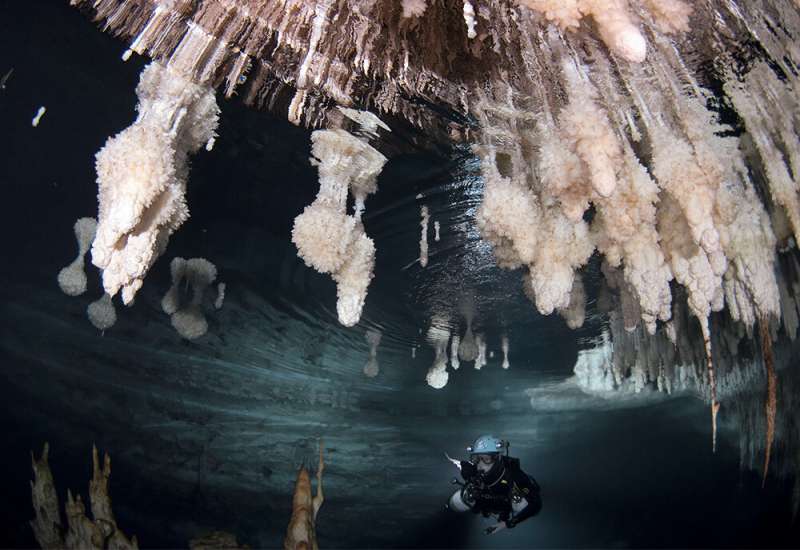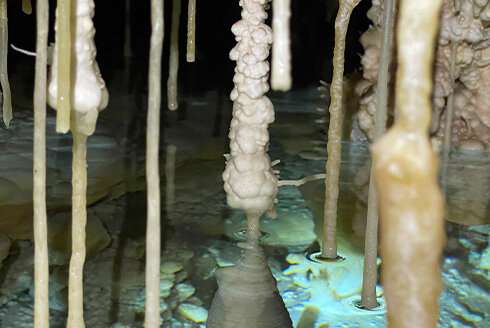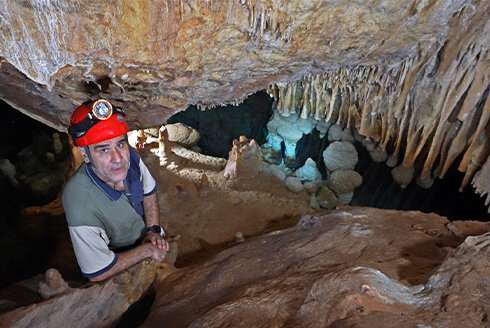Hidden in caves: Mineral overgrowths reveal unprecedented modern sea-level rise

The early 1900s were an exciting time across the world, with rapid advances in the steel, electric and automobile industries. The industrial changes also mark an inflection point in our climate. According to an international team of researchers led by the University of South Florida (USF), the sea level has risen 18 centimeters since the start of the 20th century.
The study, featured on the cover of the July 1 issue of Science Advances, works to identify preindustrial sea levels and examines the impact of modern greenhouse warming on sea-level rise.
The team, which includes USF graduate students, traveled to Mallorca, Spain—home to more than 1,000 cave systems, some of which have deposits that formed millions of years ago. For this study, they focused on analyzing deposits from 4,000 years ago to present day.
The team found evidence of a previously unknown 20 centimeter sea-level rise that occurred nearly 3,200 years ago when ice caps melted naturally over the course of 400 years at a rate of 0.5 millimeters per year. Otherwise, despite major climatic events like Medieval Warm Period and the Little Ice Age, the sea level remained exceptionally stable until 1900.
“The results reported in our study are alarming,” said lead author Bogdan P. Onac, geology professor at USF. “The sea-level rise since the 1900s is unprecedented when compared to the natural change in ice volumes over the last 4,000 years. This implies that if global temperatures continue to rise, sea levels could eventually reach higher levels than scientists previously estimated.”

To create the timeline, the team gathered 13 samples from eight caves along the coastline of the Mediterranean Sea. The deposits are rare—only forming near the coastline in cave passages that were repeatedly flooded by sea water, making them accurate markers of sea-level changes overtime. Each deposit holds valuable insight into both the past and future, helping researchers determine how quickly the sea level will rise in the coming decades and centuries.
The samples were taken to the University of New Mexico and University of Bern in Switzerland, where special instruments were used to determine their age by uranium-series method. Over time, uranium decays into other elements such as thorium and lead, allowing researchers to create a timeline of the sea level documented in each deposit.
A complex software at Harvard University helped generate predictions using various ice models and Earth’s parameters to showcase an accurate history of the sea level. These predictions are essential because they allow researchers to estimate past global mean sea level, which is key in addressing future sea-level rise.
“If humans continue to be the main driver and the temperature increases 1.5 degrees in the near future, there will be irreversible damage,” Onac said. “There will be no turning back from that point on.”

Based on ice mass loss from the Antarctic and Greenland, the average sea-level rise since 2008 is 1.43 millimeters per year.
Permanent flooding from the rising sea level won’t happen overnight, but Onac says it will be seen more and more during storm surges and hurricanes. With nearly 40 percent of the world’s population living within 62 miles of a coast, the rising sea level could be catastrophic with substantial societal and economic impacts.
“Even if we stop right now, sea level will continue to rise for at least a couple of decades, if not centuries, simply because the system is warmed up.”
Geoscientists reconstruct 6.5 million years of sea level stands
Bogdan P. Onac et al, Exceptionally stable preindustrial sea level inferred from the western Mediterranean Sea, Science Advances (2022). DOI: 10.1126/sciadv.abm6185
Citation:
Hidden in caves: Mineral overgrowths reveal unprecedented modern sea-level rise (2022, June 30)
retrieved 1 July 2022
from https://phys.org/news/2022-06-hidden-caves-mineral-overgrowths-reveal.html
This document is subject to copyright. Apart from any fair dealing for the purpose of private study or research, no
part may be reproduced without the written permission. The content is provided for information purposes only.
For all the latest Science News Click Here
For the latest news and updates, follow us on Google News.

